Moodle is a free learning management system that allows you to create powerful, flexible, and engaging online learning experiences. I use the phrase "online learning experiences" instead of "online courses" deliberately. The phrase "online course" often connotes a sequential series of web pages, some images, maybe a few animations, and a quiz, provided online. There might also be some email or bulletin board communication among the teacher and students. However, online learning can be much more engaging than that.
Moodle's name gives you insight into its approach to e-learning. From the official Moodle documentation:
The word Moodle was originally an acronym for Modular Object-Oriented Dynamic Learning Environment, which is mostly useful to programmers and education theorists. It's also a verb that describes the process of lazily meandering through something, doing things as it occurs to you to do them, an enjoyable tinkering that often leads to insight and creativity. As such it applies both to the way Moodle was developed, and to the way a student or teacher might approach studying or teaching an online course. Anyone who uses Moodle is a Moodler.
The phrase "online learning experience" connotes a more active, engaging role for the students and teachers. It connotes web pages that can be explored in any order, courses with live chats among students and teachers, forums where users can rate messages on their relevance or insight, online workshops that enable students to evaluate each other's work, impromptu polls that let the teacher evaluate what students think of a course's progress, and directories set aside for teachers to upload and share their files. All of these features create an active learning environment, full of different kinds of student-to-student and student-to-teacher interaction. This is the kind of user experience that Moodle excels at, and the kind that this book will help you to create.
When you create a Moodle learning site, you usually follow a defined series of steps. This book is arranged to support that process. Each chapter shows you how to get the most from each step. Each step is listed below, with a brief description of the chapter that supports that step.
As you work your way through each chapter, your learning site will grow in scope and sophistication. By the time you finish this book, you should have a complete, interactive learning site. As you learn more about what Moodle can do, and see your courses taking shape, you may want to change some of the things that you did in previous chapters. Moodle offers you this flexibility. And, this book helps you to determine how those changes will cascade throughout your site.
Every Learning Management System (LMS) has a paradigm, or approach, that shapes the user experience and encourages a certain kind of usage. An LMS might encourage very sequential learning by offering features that enforce a given order for each course. It might discourage student-to-student interaction by offering few features that support it, while encouraging solo learning by offering many opportunities for the student to interact with the course material. In this chapter, you will learn what Moodle can do and what kind of user experience your students and teachers will have when they use Moodle. You will also learn about the Moodle philosophy, and how it shapes the user experience. With this information, you'll be ready to decide how to make the best use of Moodle's many features, and to plan your online learning site.
This chapter guides you through installing Moodle on your web server. It will help you to estimate the amount of disk space, bandwidth, and memory that you will need for Moodle. This can help you to decide upon the right hosting service for your needs.
Most of the decisions that you make when installing and configuring Moodle will affect the user experience. Not just students and teachers, but also course creators and site administrators are affected by these decisions. Although Moodle's online help does a good job of telling you how to install and configure the software, it doesn't tell you how the settings you choose affect the user experience. Chapter 3 covers the implications of these decisions, and helps you to configure the site so that it behaves in the way that you envision.
In Moodle, every course belongs to a category. Chapter 4 takes you through the creation of course categories, and the creation of courses. Just as you chose sitewide settings during installation and configuration, you choose course-wide settings when creating each course. This chapter tells you the implications of the various course settings, so that you can create the experience that you want for each course. It also shows you how to add teachers and students to courses.
In most online courses, the core material consists of web pages that the students view. These pages can contain text, graphics, movies, sound files, games, and exercises: anything that can appear on the World Wide Web can appear on a Moodle web page. Chapter 5 covers how to add web pages to Moodle courses, and also how to add other kinds of static course material: links to other websites, media files, labels, and directories of files. This chapter also helps you to decide when to use each of these types of material.
In this context, "interactive" means interaction between the student and teacher, or the student and an active web page. Student-to-student interaction is covered in the next step. This chapter covers activities that involve interaction between the student and an active web page, or between the student and the teacher. Interactive course material includes lessons that guide students through a defined path based upon their answers to review questions, and assignments that are uploaded by the student and then graded by the teacher. Chapter 6 tells you how to create these interactions, and how each of them affects the student and teacher experience.
In Chapter 7, Evaluating Students with Quizzes, Choices, and Feedback, you'll learn how to evaluate students' knowledge with a Quiz. You will also learn how to to evaluate their attitude towards the class by using the Feedback activity. Finally, you'll learn how to evaluate students' opinions by using the Choice activity.
Social course material enables student-to-student interaction. Moodle allows you to add chats, forums, and Wikis to your courses. These types of interactions will be familiar to many students. You can also create glossaries that are site-wide and ones that are specific to a single course. Students can also add to the glossaries. Finally, Moodle offers a powerful workshop tool, which enables students to view and evaluate each others, work. Each of these interactions makes the course more interesting, but also makes it more complicated for the teacher to manage. Chapter 8 helps you to make the best use of Moodle's social features. The result is a course that encourages students to contribute, share, and engage.
Every block adds functionality to your site or your course. You can use blocks to display calendars, enable commenting, enable tagging, show navigation features, and much more. This chapter describes many of Moodle's blocks, helps you decide which ones will meet your goals, and tells you how to implement them.
Moodle offers several tools to help teachers administer and deliver courses. It keeps detailed access logs that enable teachers to see exactly what content students accessed, and when they did so. It also allows teachers to establish custom grading scales, which are available site-wide or for a single course. Student grades can be accessed online and also downloaded to a spreadsheet program. Finally, teachers can collaborate in special forums (bulletin boards) reserved just for them.
Moodle is designed to support a style of learning called Social Constructionism. This style of learning is interactive. The social constructionist philosophy believes that people learn best when they interact with the learning material, construct new material for others, and interact with other students about the material. The difference between a traditional class and a class following the social constructionist philosophy is the difference between a lecture and a discussion.
Moodle does not require you to use the social constructionist method for your courses. However, it best supports this method. For example, Moodle allows you to add several kinds of static course material. This is course material that a student reads, but does not interact with:
Web pages
Links to anything on the Web (including material on your Moodle site)
A directory of files
A label that displays any text or image
However, Moodle also allows you to add interactive course material. This is course material that a student interacts with, by answering questions, entering text, or uploading files:
Assignment (uploading files to be reviewed by the teacher)
Choice (a single question)
Lesson (a conditional, branching activity)
Quiz (an online test)
Moodle also offers activities where students interact with each other. These are used to create social course material:
Chat (live online chat between students)
Forum (you can have zero or more online bulletin boards for each course)
Glossary (students and/or teachers can contribute terms to site-wide glossaries)
Wiki (this is a familiar tool for collaboration to most younger students and many older students)
Workshop (this supports the peer review and feedback of assignments that students upload)
In addition, some of Moodle's add-on modules add even more types of interaction. For example, one add-on module enables students and teachers to schedule appointments with each other.
Because Moodle encourages interaction and exploration, your students' learning experience will often be non-linear. Moodle can be used to enforce a specific order upon a course, using something called conditional activities. Conditional activities can be arranged in a sequence. Your course can contain a mix of conditional and non-linear activities.
In this section, I'll take you on a tour of a Moodle learning site. You will see the student's experience from the time that the student arrives at the site, through entering a course, to working through some material in the course. You will also see some student-to-student interaction, and some functions used by the teacher to manage the course. Along the way, I'll point out many of the features that you will learn to implement in this book, and see how the demo site is using those features.
The Front Page of your site is the first thing that most visitors will see. This section takes you on a tour of the Front Page of my demonstration site.
Tip
Probably the best Moodle demo sites are http://demo.moodle.net/ and http://school.demo.moodle.net/.
When a visitor arrives at a learning site, the visitor sees the Front Page. You can require the visitor to register and log in before seeing any part of your site, or you can allow an anonymous visitor to see a lot of information about the site on the Front Page, which is what I have done:
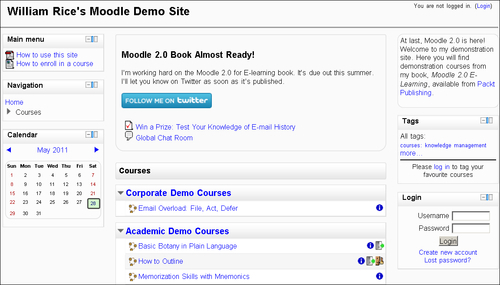
One of the first things that a visitor will notice is the announcement at the top and centre of the page, Moodle 2.0 Book Almost Ready!. Below the announcement are two activities: a quiz, Win a Prize: Test Your Knowledge of E-mail History, and a chat room, Global Chat Room. Selecting either of these activities will require to the visitor to register with the site, as shown in the following screenshot:
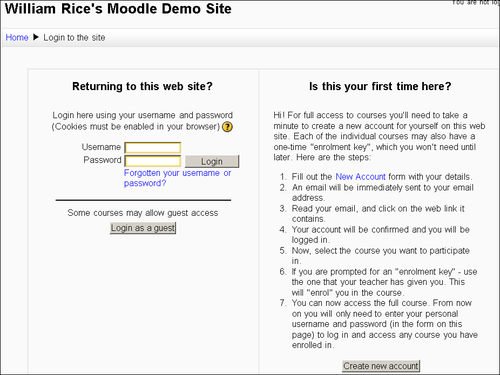
Notice the line Some courses may allow guest access at the middle of the page. You can set three levels of access for your site, and for individual courses:
Anonymous access allows anyone to see the contents of your site's Front Page. Notice that there is no Anonymous access for courses. Even if a course is open to Guests, the visitor must either manually log in as the user Guest, or you must configure the site to automatically log in a visitor as Guest.
Guest access requires the user to login as Guest. This allows you to track usage, by looking at the statistics for the user Guest. However, as everyone is logged in as the user Guest, you can't track individual users.
Registered access requires the user to register on your site. You can allow people to register with or without e-mail confirmation, require a special code for enrolment, manually create their accounts yourself, import accounts from another system, or use an outside system (like an LDAP server) for your accounts. There's more on this in Chapter 2.
Returning to the Front Page, notice the Main menu in the upper-left corner. This menu consists of two documents that tell the user what the site is about, and how to use it.
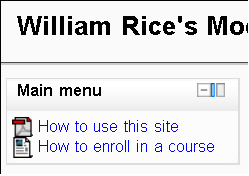
In Moodle, icons tell the user what kind of resource will be accessed by a link. In this case, the icon tells the user that the first resource is a PDF (Adobe Acrobat) document, and the second is a web page. Course materials that students observe or read, such as web or text pages, hyperlinks, and multimedia files are called Resources. In Chapter 5, Adding Static Course Material, you will learn how to add Resources to a course.
In the side bars of the page, you will find Blocks. For example, the Main menu, Calendar, and Tags blocks. You can choose to add Blocks to the Front Page and to each course, individually.
Other Blocks display a summary of the current course, a list of courses available on the site, the latest news, a list of the people who are online, and other information. In the lower-right corner of the Front Page you will see the Login Block. Chapter 9 tells you how to use these Blocks.
On the rightmost side of the Front Page you can see a Site Description. This is optional. If this were a course, you could choose to display the Course Description here.
The Site or Course Description can contain anything that you can put on a web page. It is essentially a block of HTML code that is put onto the Front Page.
You can choose to display available courses on the Front Page of your site. In the demonstration site, I've created a category for Free Courses and another for Wild Plants. Free Courses allow Guest users to enter. Courses in other categories require users to register.
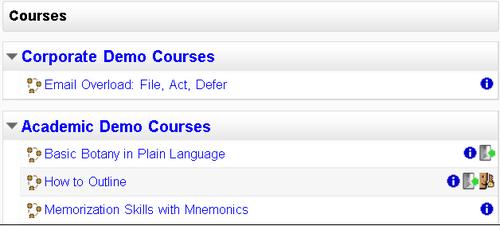
Clicking on the Information icon ![]() next to a course displays the Course Description. Clicking on a course name takes you to the course. If the course allows anonymous access, you are taken directly into the course. If the course allows guest access, or requires registration, you are taken to the Login screen.
next to a course displays the Course Description. Clicking on a course name takes you to the course. If the course allows anonymous access, you are taken directly into the course. If the course allows guest access, or requires registration, you are taken to the Login screen.
Now let us take a look inside a course.
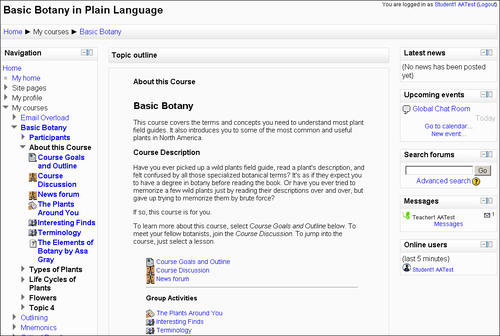
In the preceding screenshot, the user has logged in as student1 and entered the Basic Botany course. We know this from the breadcrumbs trail in the upper-left corner of the screen, which tells us the name of the site and the name of the course. In the upper-right corner of the screen, we see a confirmation that the user has logged in.
Like the Front Page, this course uses various Blocks. The most prominent is the Navigation Block on the left. Let's talk more about navigation.
The Navigation Block shows you where you are, and, where you can go in the site. In the demonstration, you can see that the student has access to several courses: Email Overload, Basic Botany, Outlining, Mnemonics, and Critical Reading. Right now, the student is in the Basic Botany course, in the topic labeled About this Course. Under that topic, you can see a variety of resources and activities.
With just a few clicks, the student can open another course and jump to a place in that course.
Earlier in this chapter, I commented on the non-linear nature of many Moodle courses. Notice that all of the resources for this course are available to the user at all times. Later, we'll discuss features that allow you to set conditions for when activities or resources become available to the student.
At the top of the Navigation Block is a link to the site's Home page. Below that, is a link to the student's home page, My home. The student's home page lists the courses that the student is enroled in, and the work that the student performs in those courses.
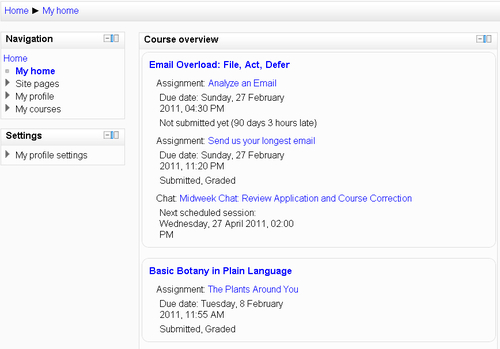
Also on the Navigation Block is a link to the student's profile, My profile. The name gives the impression that you will find information such as contact information, interests, and maybe a picture of the student, under this link. But there's actually much more under that link:
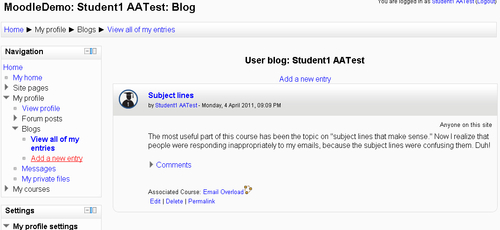
Notice that we are viewing a Blog entry made by the user. At the bottom of the blog entry, Moodle tells us what course the user made this blog entry in: Email Overload. In Moodle, when a user makes a blog entry or forum posting in a course, that entry/post appears both in the course and in the user's profile.
The user's Messages are also collected under this link. Here the user can see both received and sent messages.
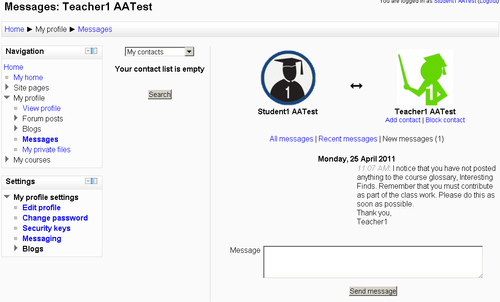
The drop-down list lets the user filter messages by person or by course.
The user's profile also contains a link to any personal files uploaded into Moodle by this user:
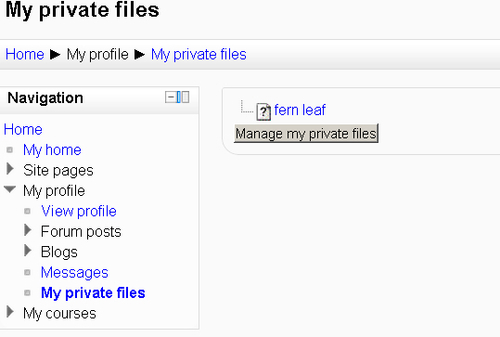
Unlike Forum posts and Blog entries, the My private files page doesn't display files that the student has uploaded to specific courses. The files here are, literally, private. However, when the student submits a file to a course, the student can select a private file and submit it to the course.
Moodle also allows you to organize a course by Week, in which case each section is labeled with a date instead of a number. Or, you can choose to make your course a single, large discussion forum. Most courses are organized by Topic, like the one shown in the following screenshot:
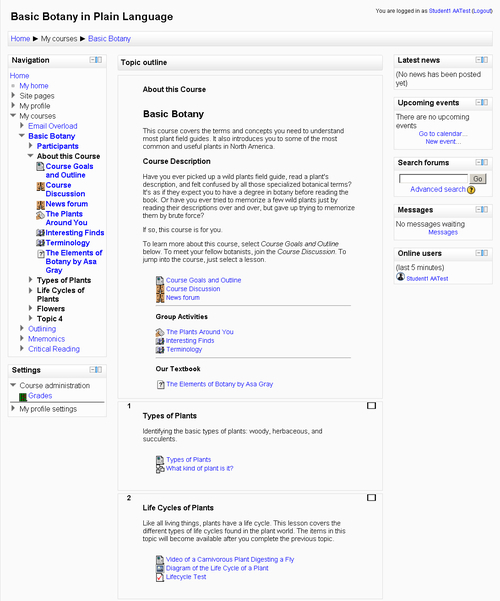
Notice that the first topic, which I've labeled About this Course, is not numbered. Moodle gives you a Topic 0 to use as the course introduction.
Teachers can hide and show topics at will. This enables a teacher to open and close resources and activities as the course progresses.
Topics are the lowest level of organization in Moodle. The hierarchy is: Site | Course Category | Course Subcategory (optional) | Course | Topic. Every item in your course belongs to a Topic, even if your course consists of only Topic 0.
Clicking on Course Discussion, under Group Activities, takes the student to the course-wide forum. Clicking on a topic line opens that thread. You can see in the following screenshot that the teacher started with the first post. Then a student replied to this post:
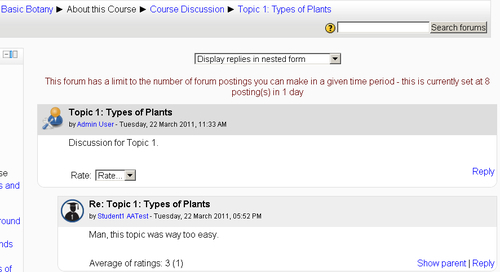
That Student's message doesn't serve our students. Fortunately, the teacher has editing rights to this forum, and so he or she can delete posts at will. The teacher can also rate posts for their relevance, as shown in the following screenshot:
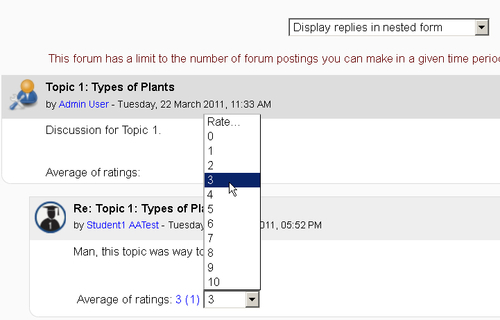
Because Moodle supports an interactive, collaborative style of learning, students can also be given the ability to rate forum posts and material submitted by other students. You'll find out more about forums in Chapter 7.
Now in our demonstration course, the student will enter a workshop called Observing the Familiar.
In this workshop, the student writes and updates some defined observations. These observations are then rated by other students of the course. When the student first enters the workshop, he or she sees instructions for completing the workshop, as shown in the following screenshot:
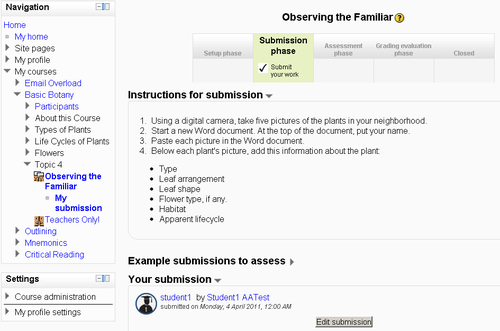
After reading these instructions, the student continues to the workshop submission form:
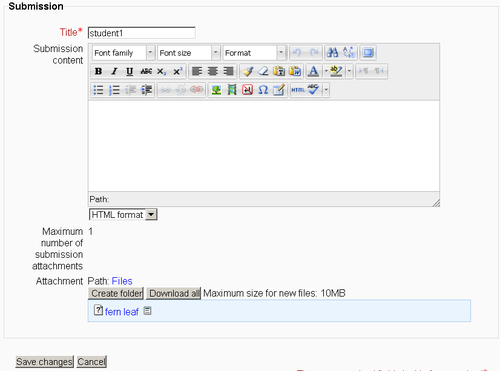
Notice the online word processor that the student uses to write the assignment. This gives the student basic WYSIWYG features. The same word processor appears when course creators create web pages, when students write online assignment entries, and at other times when a user is editing and formatting text.
Let us see what happens when you turn on the editing mode to make changes.
When a guest user or a registered student browses your learning site, Moodle displays pages normally. However, when someone with course creator privilege logs in, Moodle offers a button for switching into editing mode:

Clicking on Turn editing on puts Moodle into Editing mode:
|
Normal Mode |
Editing Mode |
|---|---|
 |
 |
Let's walk through the icons that become available in editing mode.
Clicking the Edit icon ![]() allows you to edit whatever that icon follows. In this example, clicking on the Edit icon that follows the paragraph allows you to edit the announcement, as shown in the following screenshot:
allows you to edit whatever that icon follows. In this example, clicking on the Edit icon that follows the paragraph allows you to edit the announcement, as shown in the following screenshot:
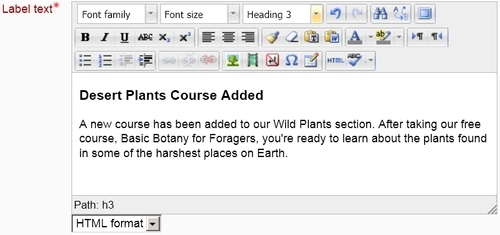
Clicking on the Editing icon next to the quiz Win a Prize takes you into the editing window for that quiz. In that window, you can create, add, and remove quiz questions, change the grading scheme, and apply other settings to the quiz.
Clicking on the Delete icon ![]() deletes the item that the icon follows. If you want to remove an item from a course, but you're not sure if you'll want to use it later, don't delete the item; instead, hide it from view. Hiding and showing items is explained in the following section.
deletes the item that the icon follows. If you want to remove an item from a course, but you're not sure if you'll want to use it later, don't delete the item; instead, hide it from view. Hiding and showing items is explained in the following section.
I call these the Hidden/Shown icons ![]() /
/![]() instead of Hide/Show because the icons indicate the current state of an item, instead of indicating what will happen when you click on them. The Hidden icon indicates that an item is hidden from the students. Clicking on it shows the item to the students. The Shown icon indicates that an item is shown to the students. Clicking on it hides the item from the students.
instead of Hide/Show because the icons indicate the current state of an item, instead of indicating what will happen when you click on them. The Hidden icon indicates that an item is hidden from the students. Clicking on it shows the item to the students. The Shown icon indicates that an item is shown to the students. Clicking on it hides the item from the students.
If you want to remove an item from a course while keeping it for later use, or if you want to keep an item hidden from students while you're working on it, hide it instead of deleting it.
The ![]()
![]()
![]() icons indicate what Group mode has been applied to an item. Groups are explained in a later chapter. For now, you should know that you can control access to items based upon what Group a student belongs to. Clicking on these icons allows you to change this setting.
icons indicate what Group mode has been applied to an item. Groups are explained in a later chapter. For now, you should know that you can control access to items based upon what Group a student belongs to. Clicking on these icons allows you to change this setting.
Course material that a student observes or reads, such as web or text pages, hyperlinks, and multimedia files—are called Resources. Course material that student interacts with, or that enables interaction among students and teachers, are called Activities. Now let us see how to add some Resources and Activities to your Moodle site.
In Editing mode, you can add Resources and Activities to a course. Moodle offers more Activities than Resources, including Chat, Forum, Quiz, Wiki, and more.
You add Resources and Activities by using the drop-down lists that appear in Editing Mode:
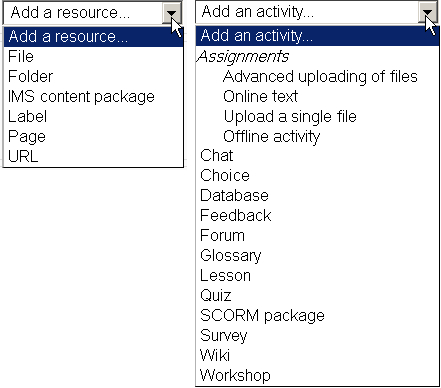
Selecting an item brings you to the Editing window for that type of item. For example, selecting URL displays the window to the right. Notice that you can do much more than just specify a hyperlink. You can give this link a user-friendly name, a brief description, open it in a new window, and more.
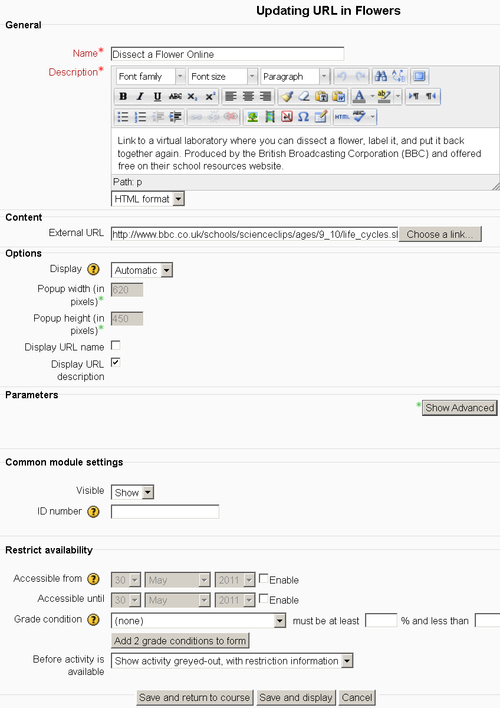
Almost every Resource and Activity that you add to Moodle has a Description. This Description appears when a student selects the item. Also, if the item appears in a list (for example, a list of all the Resources in a course), the Description is displayed in the list.
When building courses, you will spend most of your time in the Editing windows for the items that you add. You will find their behavior and appearance to be very consistent. The presence of a Description is one example of that consistency. Another example is the presence of the Help icon ![]() next to the title of the window. Clicking on this icon displays an explanation of this type of item.
next to the title of the window. Clicking on this icon displays an explanation of this type of item.
The full contents of the Settings menu are displayed only when someone with administration or course creator privileges has logged in. The following screenshot shows the teacher's view of the Settings menu:
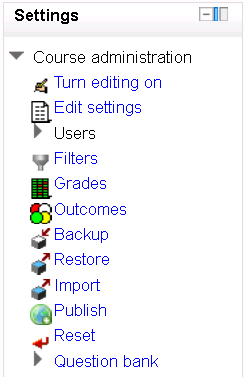
The choices on this menu apply to the course itself. If a teacher, administrator, or course creator selects an activity or resource in the course, a Settings menu for that item will appear, as shown in the following screenshot:

Notice that the items that used to be under the course settings menu are now under a Course administration menu.
This short tour introduced you to the basics of the Moodle experience. The following chapters take you through installing Moodle and creating courses. If you work through these chapters in order, you will discover many features that were not mentioned in this tour. Also, because Moodle is open source, new features can be added at any time. Perhaps you will be the one to contribute a new feature to the Moodle community.
Moodle runs on any web server that supports the PHP programming language, and a database. It works best, and there is more support, when running on the Apache web server with a MySQL database. These things, Apache, PHP, and MySQL are common to almost all commercial web hosts, even the lowest cost ones.
The Moodle learning management system resides in three places on your web host:
The application occupies one directory, with many subdirectories for the various modules.
Data files that students and teachers upload—such as photos and assignments—reside in the Moodle data directory.
Course material that you create with Moodle (web pages, quizzes, workshops, lessons, and so on), grades, user information, and user logs reside in the Moodle database.
The
screenshot below shows you my Moodle application directory. Without even knowing much about Moodle, you can guess the function of several directories. For example, the admin directory holds the PHP code that creates the administrative pages, the lang directory holds translations of the Moodle interface, and the mod directory holds the various modules:
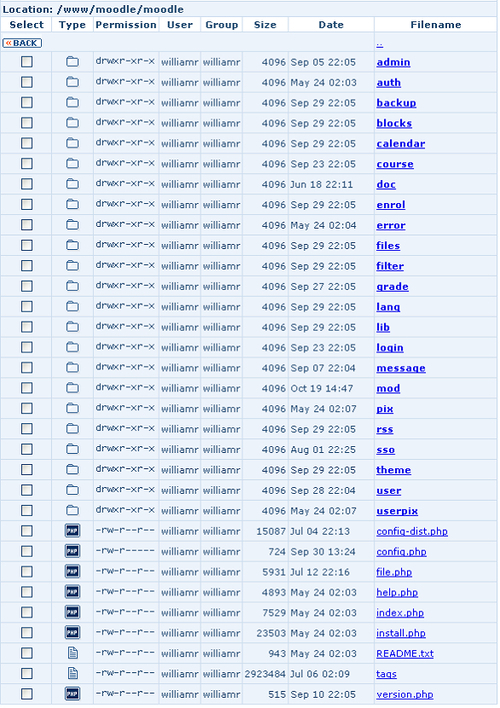
The index.php file is the Moodle home page. If a student were browsing my Moodle site, the first page that the student would see is the file http://moodle.williamrice.com/index.php.
On my site, the free course Basic Botany for Foragers happens to be course number 4. Only the Moodle system knows it as course number 4; we know it as Basic Botany for Foragers. When a student enters that course, the URL in the student's browser reads http://moodle.williamrice.com/moodle/course/view.php?id=4. In the preceding screenshot, you can see that /course is one of the directories in my Moodle installation. As the user navigates around the site, different .php pages do the work of presenting information.
As each of Moodle's core components and modules is stored in its own subdirectory, the software can be easily updated by replacing old files with newer ones. You should periodically check the http://www.moodle.org website for news about updates and bug fixes.
Moodle stores
files uploaded by the users in a data directory. This directory should not be accessible to the general public over the Web. That is, you should not be able to type in the URL for this directory and access it using a web browser. You can protect it either by using an .htaccess file or by placing the directory outside of the web server's documents directory.
In my installation, the preceding screenshot shows you that the web document directory for moodle.williamrice.com is /www/moodle. Therefore, I placed the data directory outside of /www/moodle, in /www/moodledata:
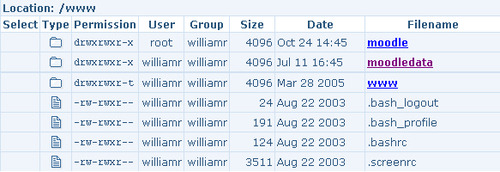
On my server, the directory /www/ moodledata corresponds to the subdomain www.moodledata.williamrice.com. This subdomain is protected from open access by an .htaccess file. The directory /www/ www corresponds to the root domain, www.williamrice.com.
When the Moodle data directory stores files uploaded by students, the Moodle database stores most of the information in your Moodle site. The database also stores objects that you create using Moodle. For example, Moodle enables you to create web pages for your courses. These web pages' actual HTML code is stored in the database. Links that you add to a course, the settings and content of forums and Wikis, and quizzes created with Moodle, are all examples of data stored in the Moodle database.
The three parts of Moodle: the application, data directory, and database, work together to create your learning site. However, knowing how the three parts work together is also helpful when upgrading, troubleshooting, or moving your site between servers.
Moodle encourages exploration and interaction between and among students and teachers. As a course designer and teacher, you will have most of the tools at your disposal if you work with this tendency in mind, and make your learning experiences as interactive as possible. Creating courses with forums, peer-assessed workshops, surveys, and interactive lessons is more work than creating a course from a series of static web pages. It is also more engaging and effective, and you will find it worth the effort to use Moodle's many interactive features.
When teaching an online course in Moodle, remember that Moodle allows you to add, move, and modify course material and grading tools on-the-fly. If it's permitted by your institution's policies, don't hesitate to change a course in response to student needs.
Finally, learn the basics of Moodle's architecture, and at least read over the Installation and configuration section in Chapter 2. Don't be afraid of the technology. If you can master the difficult art of teaching, you can master using Moodle to its full potential.





















